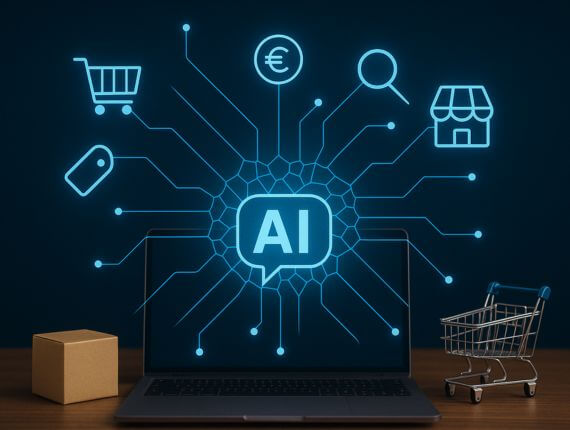Generative AI: A new customer acquisition channel

One of the emerging trends in consumers’ online shopping routines is the use of Generative AI solutions. This marks another transformation impacting the retail industry. Generative artificial intelligence is becoming an increasingly important shopping tool. To succeed, retailers must learn how to leverage AI-powered tools to promote their products and services.
The Rapid Rise of AI Traffic
Adobe examined consumer behaviour during the 2024 holiday shopping season (November-December). It turned out that many consumers used Generative AI tools (such as ChatGPT or Gemini) during their shopping journey to search for products, discounts, or gift ideas.
Consequently, in the period between November 1 and December 31, 2024, traffic from Generative AI tools (measured by the number of link clicks) to US online stores grew by 1300% year-over-year (YoY). Cyber Monday saw a 1950% YoY increase. While traffic from Generative AI tools to e-stores remains relatively modest (compared to other customer acquisition channels), it is growing at an unprecedented rate.
In July 2025, an off-peak shopping month, this traffic saw an astonishing increase of 4700% YoY! Consumers are increasingly incorporating AI into their daily shopping routines, making it a new, mass-market channel for reaching customers.
The Largest Analysis of Its Kind
Adobe’s research was based on an analysis of transactions across US online stores, covering over 1 trillion visits and making it the largest analysis of its kind in history. Additional insights into how consumers use AI in online shopping came from a survey of over 5,000 respondents in the United States.
38% of respondents said they had used Generative AI while shopping online, and 52% plan to do so this year. Shopping prompts include searching for information (53% of responses), receiving product recommendations (40%), looking for deals (36%), creating shopping lists (30%), finding gift ideas (30%), searching for unique products (29%), and virtual try-ons (26%).
Valuable Traffic
Initial concerns about the low quality of traffic from AI-powered tools can be considered unfounded. Data collected by Adobe shows that users who arrive at an e-store via Generative AI tools are significantly more engaged — they spend 32% more time on the site and view 10% more pages during their visit. Moreover, their bounce rate is 27% lower than for consumers coming from other sources. This data suggests that AI acts as an advanced “filter,” directing better-informed and more purchase-ready consumers to the e-store. They are not random visitors, but potential customers. Furthermore, 85% of people who used Generative AI while shopping said it improved their shopping experience, and 73% cited it as their main source of product information. Additionally, 83% claim they are more likely to use AI for larger or more complex purchases.
Conversion Rate Surge
Perhaps the most crucial information for retailers, however, concerns the conversion rate (the percentage of visits ending in a purchase). In January 2025, the conversion rate for AI traffic was 49% lower compared to traditional sources, but by July 2025, this difference had narrowed to just 23%. Consumers are increasingly willing to transact immediately after using AI-powered tools, rather than just using it for product search and consideration.
This positive change in the conversion rate directly translates into revenue per visit, which grew by 84% between January and July 2025. This means an AI-powered visit in July 2025 was worth only 27% less than a visit from other channels, a significant improvement from the previous year (97% less in July 2024).
This trend is expected to accelerate with the growing popularity of Generative AI tools on mobile devices, where impulsive purchases are more common. In July 2025, 26% of Generative AI-driven traffic came from mobile devices, up from 18% in January 2025.
The Customer Race on New Terms
As consumers readily use Generative AI-powered tools for everyday tasks — such as online shopping — e-commerce companies must rethink how they engage different audiences. This is especially important with the emergence of AI agents that will be able to perform more complex tasks and provide highly personalized recommendations.
AI is transforming from a simple search engine into a virtual assistant that accompanies the customer even during online shopping. The race for the customer is becoming a race for visibility within AI algorithms for retailers.
This blogpost was prepared based on the Adobe article: Generative AI-powered shopping rises with traffic to U.S. retail sites up 4,700%.

